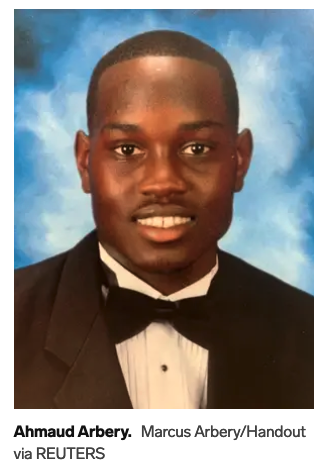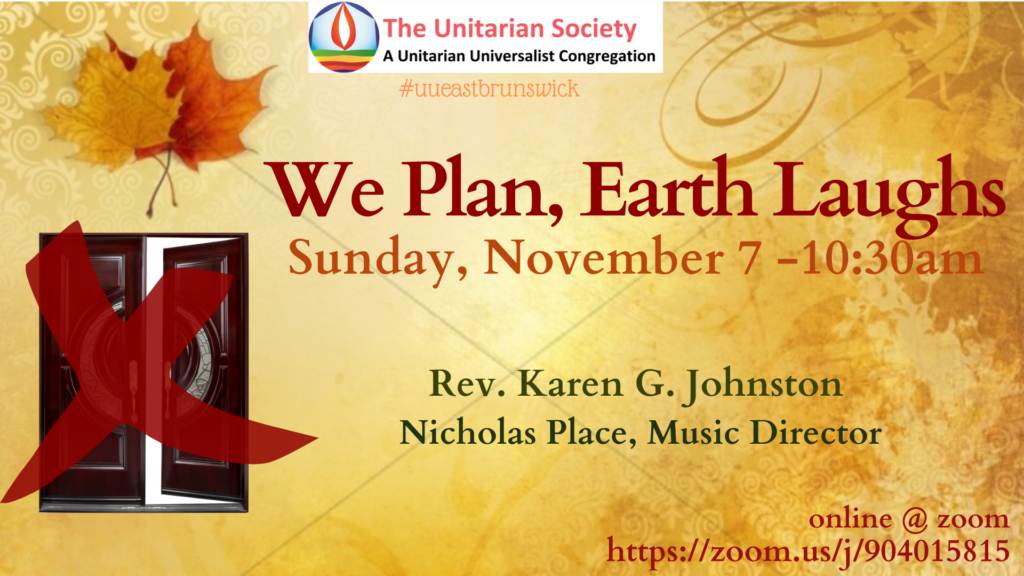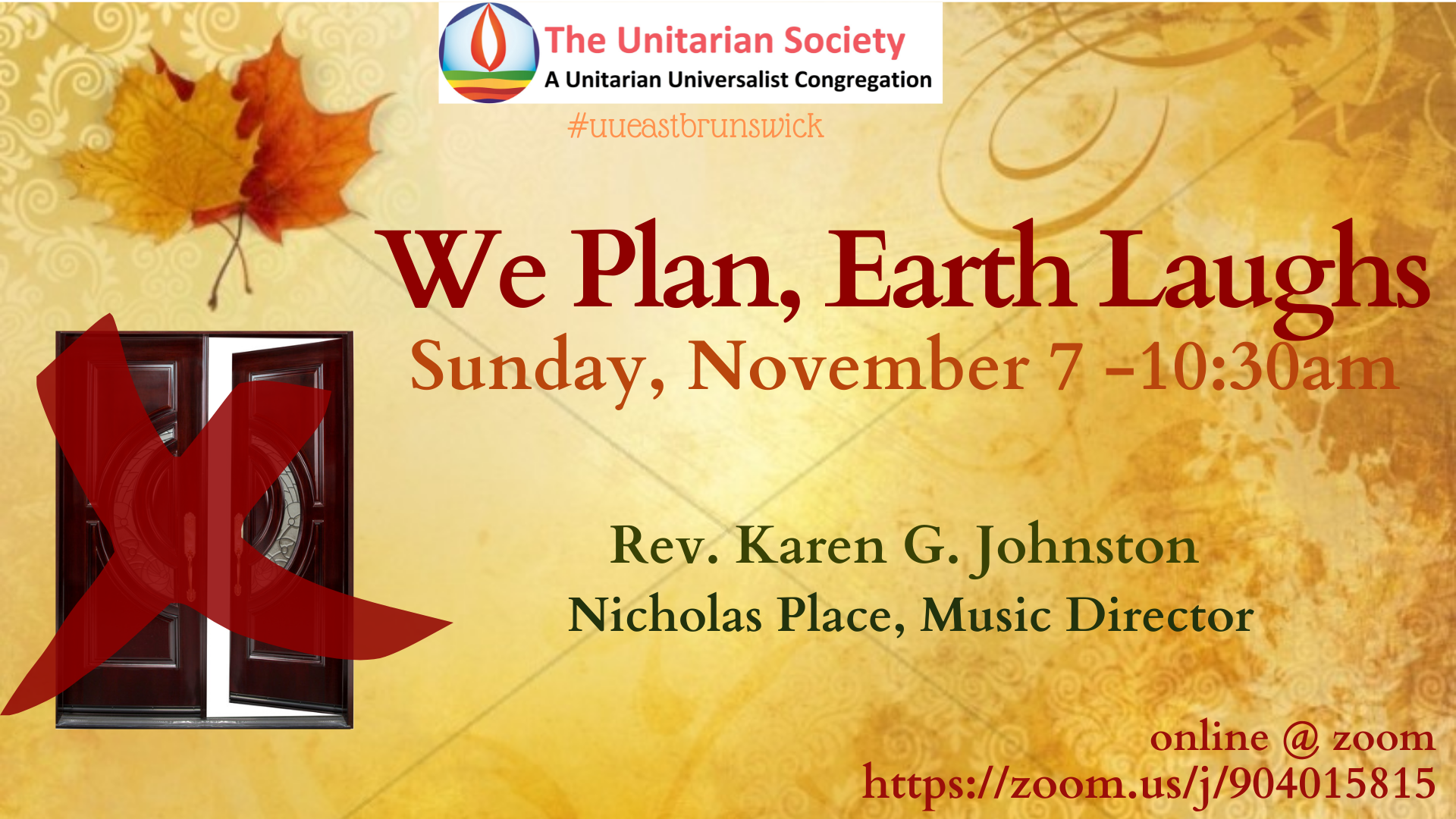November 7, 2021
The Unitarian Society, East Brunswick, NJ
Reverend Karen G. Johnston
A true story that comes to us from our sibling congregation in Amherst, Massachusetts:
In 1919, The Rev. Henry Ives was called by the church. During his 10 years in Amherst, membership grew. In 1925, the meetinghouse was renovated to better accommodate the congregation’s size — with unexpected results.
For there had been a stowaway in the shipment of building materials!
As The Rev. Ives later wrote, “It belonged to the vegetable kingdom. Apparently, it started with the new-laid wooden floor of the [basement] social room and stretched its greedy way to eat the life out of the beams and timbers which supported the roof. It crept up the walls like a thief in the night . . . North Carolina pine crumpled like dust after it had eaten its greedy meal from the pores of the wood. The back stairs might have fallen at the first real test of their strength. Huge blossoms like gigantic toadstools appeared where the floor and walls met. Scientists called this foe the house fungus and Unity Church became a Mecca for students of fungus diseases.”
I am not a fan of creating hierarchies of suffering. I think it does more harm than good. Sometimes, when we try to put our own challenges in perspective, we can go too far, by elevating the problems of others and minimizing too much our own. We can do this too early in the emotional process, jumping to acceptance before we do the work of grappling with the challenge itself.
Both those things said, hearing this story helped me put into perspective the setback we experienced this week with the discovery of mold throughout our sanctuary and the disappointing delay of our return to holding Sunday services in the building. There are no gigantic toadstools blossoming. No timber is falling to dust. This was not a violation at the hands of some vandal, which would carry with it a trauma that this does not hold.
We just have fungus among us.
Nothing more. Nothing less. And it is ours to address.
Like Chris, who shared his reflections upon seeing the footage last week of our ancestors and the breaking ground to build this building, I have been thinking especially about the image of the shovel going into the hillside. In the grainy, jumpy video, you can see one of our ancestors, one of this congregation’s founders, using the back of the shovel to move away leaves, to get better leverage when sinking the shovel into the dirt. You can’t hear the shovel breaking the surface, but in my mind’s eye, I can almost feel that initial resistance, and then the give of the soil to the blade. I wasn’t thinking these thoughts last week as I watched that footage from inside the sanctuary, but ever since I learned about the mold, I have thought that soil – the soil on that shovel back in 1963 or ’64 contained as all soil does spores of all sorts of molds, perhaps even some not-so-distant relative of the mold that found a fecund home in our sanctuary during the height of the pandemic.
It has been hard not to feel the weight of the challenges of this building this week, this past month. Yes, now the mold, but before that it has been water damage, leaks and replacing walls. It has been roofs that have seen better days. It is the financial responsibility to clear snow even when the building is closed. Trying to figure out how to address air quality concerns during a pandemic with a closed ventilation system and a room full of beautiful, idiosyncratic triangular windows.
It’s a bit ironic, that just on the cusp of returning to the building, after more than a year and a half of being away, I feel the need to remind us that the church is not the building. The church is the people. And anytime a congregation gets confused about this, anytime a congregation begins to be more in love with the building than the mission, problems ensue.
There are people in this congregation who love this building. Who have loved it for decades. People who have accepted the mantel handed to them directly from the founders who loved our whacky building with its award-winning design that has done little for the following generations, for its design has brought headaches when pursuing the upkeep. So god bless the people who love this building and who will sacrifice to sustain it. For I think there is in our near future a need to sacrifice in order to fix this.
The first time I walked into the sanctuary, I knew this was the congregation I was meant to serve. But I’m not sure I consider myself among the group of people who love the building. I feel like my relationship is more of a love-hate kind of thing. Definitely love, but also: well, let’s just say I have cursed the building and its oddities and challenges far more than once.
Ultimately, it matters little what I think of the building. I am just the Minister. And that may sound funny to some of our newer members, but it’s true. Because ministers come and go, but you all, dear ones: you are the owners of this place, together, collectively. You are the owners of the building, the property, the parsonage (yes, you are responsible for the house in Somerset where me and my family live). You get to make the easy decisions (what color to paint the restroom walls) and you must make the hard decisions (how to raise the funds? when is it too much? has our love of building outsized our love of mission?).
~~~
Our mold is a real problem. It has already taken hours and hours of labor and attention and that is just the beginning. It will take some of our financial resources. It is real. And it is our problem, no one else’s. If we ignore it, it won’t get fixed. So it needs us.

And I want to remind us that this week, the jury was picked for the trial of the killers of Ahmaud Arbery, the unarmed Black jogger chased by white men with guns in a truck and killed in February, 2020, in Brunswick, Georgia, includes one Black juror. One. In a county that is 24% African American.
I want to remind us that there are 200 Afghans who had to flee their nation when the military of this nation’s government ended its presence there after twenty long year and who are now hoping to make their home here in Central Jersey.
So while the mold is a problem and it is our problem, we must place it in context.
~~~
When I am discouraged, I find it helps to know that I am not alone. I had that experience in talking with our insurance company, when they told me that they are getting scores of claims just like ours from other houses of worship. It was disappointing when they said this damage is not covered by our insurance. Hearing that we were not alone helped soften the blow just a little. I mean, it would have been WAY better to learn that our insurance would help pay the bill, but I guess we can’t have everything.
I do find it better to go through discouraging times in good company. When I came to fully comprehend what we are facing with this mold problem, I turned to crowdsourcing among my colleagues. First, I turned to them for the healing of sympathy. Then I turned to them for the healing of humor. Since I knew that our service this Sunday could no longer be titled, “Enter, Rejoice and Come In,” I asked them for alternatives, serious or funny.
I tell you, much to my surprise, for I was feeling quite defeated, I went to bed laughing. And in the morning, when I looked again, there are more suggestions, so I started the day laughing too. Here are many of their suggestions.
Some were of a general ilk:
Not What We Planned
Murphy’s Law: A Theological Reflection
Good News and Bad News: Well, at least it’s not Covid…
And the winning selection:
We Plan, Earth Laughs

Some went straight for the mold angle:
Come Bleach Some Seats with Me
Molding the Future
It’s a Moldy but a Goodie
A Church That Doesn’t Fit the Mold
There is Spore Love Somewhere
Some decided that mold and fungus are enough alike:
The Problem has Mushroomed
A Truly Inclusive Religion: Our Friend the Fungus
A Morel Dilemma (or When Shiitake Happens)
Some worked the growth aspect:
Church Growth in the Post-COVID Era: Exceeding Expectations!
Exponential Growth is Easy
Not What We Meant: Congregational Growth
A Culture for Unimagined Growth
And a few more worthy of our attention:
Alive with Possibility
Jesus *Should* Have Taken the Wheel
Okay, but Do Spores Pledge?
Wheezy Does It
Not only do I have clever colleagues, I have colleagues that let me know that I am not alone, that let me know that WE are not alone.
Right now, I can only see the bad luck of this situation. I do not have the equanimity that the old farmer from our Time For All Ages showed in the face of all the different events happening in his life. Bad luck? Maybe, he says. Good luck? Maybe, he says. I appreciate the parable, my mind welcomes its message, but my heart is stuck in the certainty that this is bad luck. And…
…and I am willing to suspend not my disbelief, but the certainty I feel, and be open to the maybe. Be open that we do not know what will come of this challenge. Already, I have experienced spontaneous acts of generosity from colleagues and congregants alike. THAT has felt like good luck. Like good fortune. Like blessing.
Let me tell you what happened to what was then called Unity Church and is now the Unitarian Universalist Society of Amherst, after their bad luck from the vegetable kingdom. These words are from their website history:
The Rev. Ives asked the AUA for financial help to save the building. The reply was that it had none to offer, but Unity Church could have two sets of beautiful and valuable memorial stained glass windows by John La Farge and Louis C. Tiffany. These had been created for All Souls Unitarian Church in Roxbury, MA. The windows’ donors had stipulated that if the building was ever purchased by a different denomination, its many memorial windows should be given to other Unitarian churches. In 1923, All Souls’ members had merged with First (Unitarian) Church of Roxbury. The All Souls building was now on the market, so the AUA offered two sets of windows to Unity Church. Unity Church successfully raised enough funds to repair the building, complete the remodeling, and pay for the installation of the windows from Roxbury.
This is not the first challenge this congregation has encountered. It is not the last. That it is happening in the midst of a pandemic makes it harder, adding to the accumulation of loss, disappointment, and discouragements. Yet, we are a hardy people. We shall not let it stop us from being a congregation that knows we are more than a building. We shall not let it stop us from seeing all that there is to celebrate: that we never closed, that we continue to meet in many different ways (right now, virtually; at 12:15, in person outdoors for fellowship; at 2pm, as part of the wider community in support of refugees and making our home their home), that there has been such great joy in seeing photos of children getting their first covid vaccinations (hallelujah).
May this latest challenge hold within it unexpected delight, spontaneous acts of generosity, and kindness more than we deserve.
So be it. See to it. Amen.
